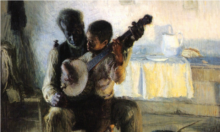African music has always influenced other musical genres. When slaves came to the Appalachian Mountain region from Africa, they brought over a lot of their traditions. Most of these traditions are shown frequently in the music world, especially in bluegrass music.
It is already known that the 4-string banjo originated from Africa, along with oral tradition. The first banjos were made with a gourd sound chamber. Five elements that compose a banjo include the sound chamber, head (vibrating membrane), neck, bridge, and the strings. The most important part is the bridge as it transmits sound from the strings to the head. However, early banjos from Africa did not have bridges. The strings on early banjos were made from “…silk to dried bird gut to horsehair to vine or twine” (Conway 169). In 1856, wire, along with fishing line were introduced to be use as strings. The chamber was made from any animals skin available, whether it was goat, horse, cow, raccoon, snake, etc. (170). Furthermore, the rims were made of either gourds or wood. Gourd rims came from Africa, while Europeans adapted the wooden rims. Wooden rims soon became popularly used because gourds were not easily accessible throughout the year in some regions and were very fragile (174). Soon after these changes, white Americans changed the number of strings to five. This change to five strings made the banjo the only original folk instrument in America (190).
Another African musical influence in bluegrass is the singer’s vocal traits. Bluegrass singers are of some distinction, but are very much like their African musical counterparts. Singers will wail, moan, and sometimes shout in the middle of a song to emphasize what they are feeling. The voice can be the most powerful element in a song. Most songs are sung in harmony, as in most black Baptist churches. Some groups, both black and white, will sing accapella tunes that give that eerie, lonesome feeling to the song. Sometimes one will not be able to follow the words, but become mesmerized by the vocal quality in the tune. The lead singer usually has a tenor singing voice and hit amazingly high notes. Bill Monroe was one of few that were able to “climb up from a pledging style in a middle register into a more forceful calling style at higher pitches” (Cantwell 212).
